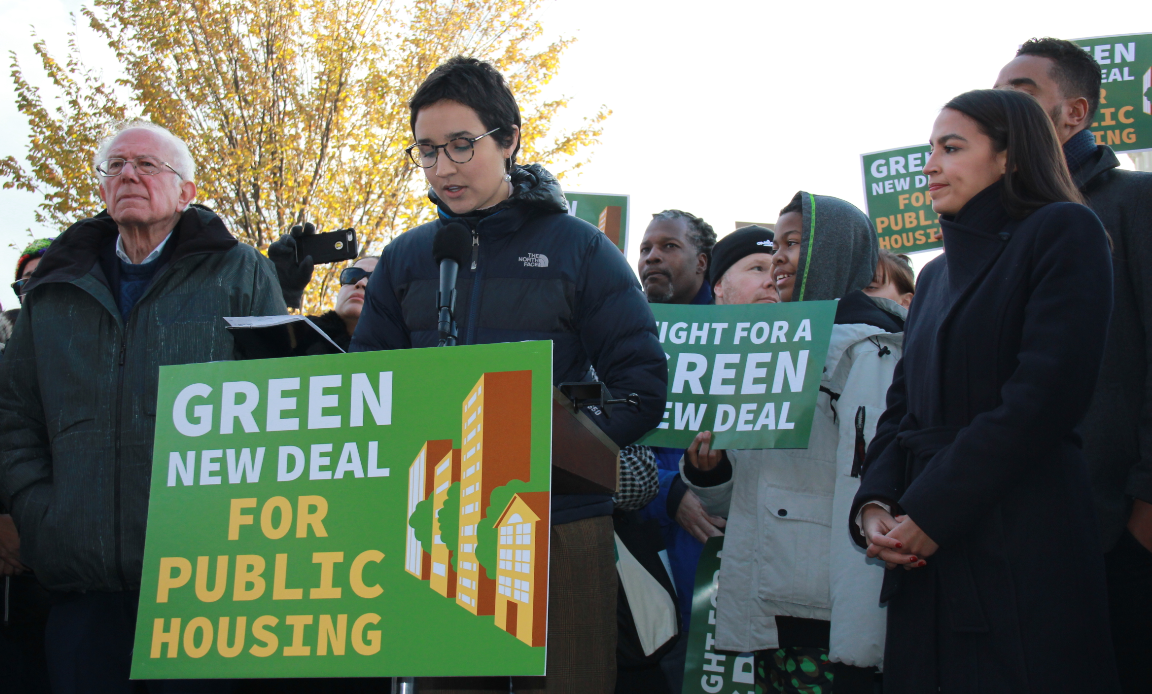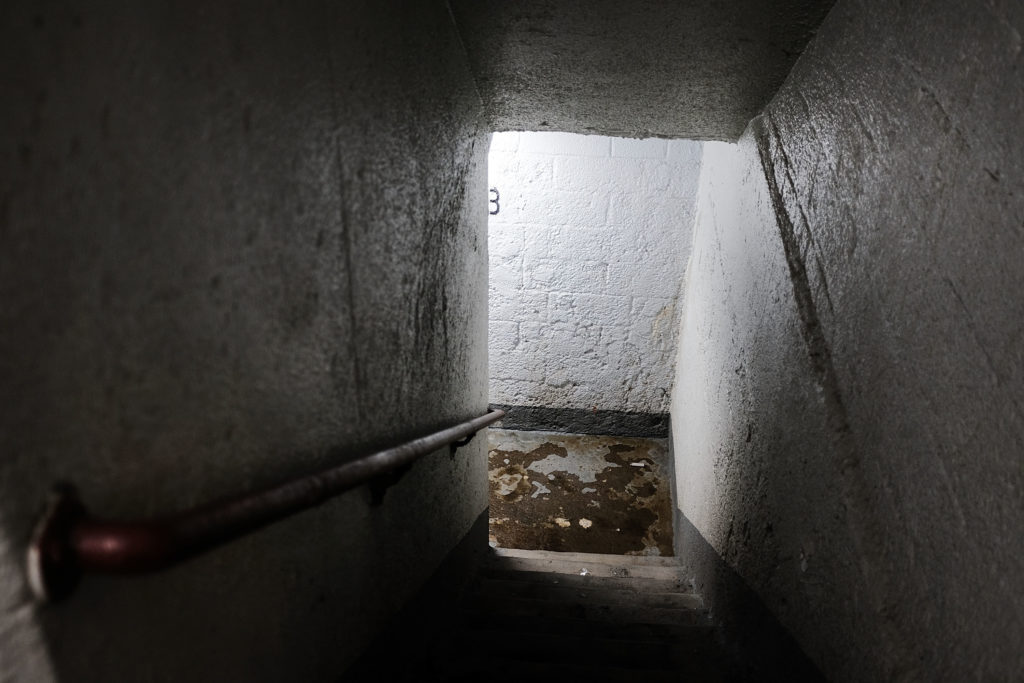Why We Need a Green New Deal for Public Housing
By centering equity, directly addressing the needs of working-class communities, and moving us closer to urgent emissions reduction goals, the Green New Deal for Public Housing shows that intersectional climate solutions are the future of climate policy.
Last November, days after I finished working on the midterm elections with Sunrise Movement, I sat in Speaker Nancy Pelosi’s office alongside hundreds of other young people, demanding that the incoming House Democratic majority back the Green New Deal. We were joined by the recently elected, but not yet inaugurated, congresswoman Alexandria Ocasio-Cortez. It has been nearly a year since the sit-in, and the Green New Deal has gone from a relatively unknown policy idea to a defining component of the progressive agenda. It’s been endorsed by every major Democratic contender for president, over 100 members of Congress have signed on as co-sponsors of the Green New Deal resolution, and thousands of young people across the country, including myself, have mobilized to make the Green New Deal a reality.

Despite this momentum, many have expressed skepticism about the viability of a Green New Deal, with some lawmakers even calling it a “Green Dream.” But, this past November, on the eve of the one-year anniversary of the sit-in, Representative Ocasio-Cortez and Senator Bernie Sanders demonstrated that the Green New Deal isn’t a dream—it’s a legislative and policy agenda that can be codified into law. They demonstrated this by introducing the Green New Deal for Public Housing Act into Congress (S.2876, H.R.5185).
Overall, the bill aims to decarbonize the United States’ public housing stock while centering justice and equity by drastically improving the living conditions of public housing residents. Specifically, it will do the following:
- Transition public housing developments to net-zero energy consumption, which would reduce carbon emissions and help to stop the climate crisis. This will be accomplished by improving the energy efficiency of buildings and incentivizing developments to become net-producers of energy. In other words, this bill provides the resources for public housing communities to install things like energy-efficient windows, electric heat pumps, and renewable energy rooftops to reduce their energy consumption, and even to produce some of their own energy.
- Develop a workforce of trained public housing residents to help provide the labor needed to accomplish the transition to maximum energy efficiency. This means encouraging workforce development programs and innovating existing public housing laws in order to maximize the economic empowerment of low-income public housing residents.
- Eradicate environmental injustice in public housing by ensuring that all public housing units meet the highest health and safety standards. Public housing authorities will receive funding to do things like enact water quality upgrades and install state-of-the-art, all-electric kitchen appliances and energy-efficient air filters.
The bill draws an explicit connection between housing and climate justice, marking a definitive shift in the policy priorities of the climate movement—a movement which has for far too long been defined by siloed, out-of-touch policy solutions that often burden already vulnerable communities. By centering equity, directly addressing the needs of working-class communities, and moving us closer toward urgent emissions reduction goals, the Green New Deal for Public Housing shows that intersectional climate solutions are the future of climate policy.
Why Public Housing?
Public housing residents—whose ranks are majority people of color, and entirely poor or working-class—represent exactly the kind of front-line community that have the most to lose in the climate crisis, yet have been historically excluded from the climate movement as a whole—and even from many policies ostensibly meant to expand opportunity. For example, the original New Deal, which established the National Housing Act and many of the housing authorities that still exist today, infamously excluded black people and women from many benefits. The impacts of this exclusion have been far-reaching and persist to this day, as the wealth gap between black families and the white families that joined the middle class thanks to New Deal programs continues to grow. This time around, with the Green New Deal, we must do better.
The Green New Deal for Public Housing bill promises to do just that by refusing to frame climate change as its own, separate issue; instead, it offers solutions to two critical problems at once. The first is the sub-humane living conditions that countless public housing residents are forced to live in, due in large part to decades of funding cuts and predatory privatization efforts. The second problem is that our planet is on fire: according to leading climate scientists, we have until 2030 to slash global greenhouse gas emissions in half. So, how do these issues connect?
To stop climate change, we need a war-time-like mobilization that, as the Green New Deal resolution states, includes “upgrading all existing buildings in the United States and building new buildings to achieve maximum energy efficiency, water efficiency, safety, affordability, comfort, and durability, including through electrification.” There’s no question that upgrading all existing buildings in the United States is no small task. What better place to start than with the 900,000 buildings and structures that the federal government already owns and manages? As the largest building owner in the United States, the federal government has a unique opportunity to lead the way in achieving 100-percent building energy efficiency country-wide. Furthermore, why not start with public housing buildings that are already in dire conditions and actively exposing people to harm?

Over 2.1 million low-income Americans live in public housing; and an astonishing number of them are exposed to inhumane, toxic living conditions on a daily basis. There is a $22 billion-to-$32 billion dollar backlog in desperately needed repairs in housing authorities across the country. For instance, in the New York City Housing Authority (NYCHA), which serves 400,000 residents, there is a three-year backlog in repair requests alone. These injustices are occurring even though the federal government has already legally committed to promoting “the goal of providing decent and affordable housing for all citizens.”
This fall, I visited several NYCHA communities with Movement School, a grassroots organization building people power in New York City public housing, and saw first-hand the injustices imposed upon residents waiting for repairs. It’s important to understand how dire some of these needed “repairs” are: they’re not simply a matter of leaky faucets or a noisy refrigerator. Many of them are life-threatening structural and environmental hazards. Jasmin Sanchez, a Movement School-trained activist I met who volunteered to help elect Ocasio-Cortez and is a resident of Baruch Houses, a NYCHA development in the Lower East Side, offers just one example. Sanchez told me about how she has had asbestos and mold in her apartment, and even had to take the New York City Housing Authority, the nation’s largest public housing agency, to court over massive leaks. Climate-fueled disasters like Hurricane Sandy only worsen these conditions, and are on the rise. Each day that these repair backlogs persist and renovations aren’t made is another day that people like Jasmin are forced to put their health at risk simply to have a place to live.
Green New Deal for Public Housing Act
The Green New Deal for Public Housing Act is legislation that finally takes these issues as seriously, and equitably, as they deserve to be treated. In the case of the backlog of unaddressed life-threatening housing hazards discussed above, the bill allocates critical funds to make repairing and eradicating them happen faster—and in an environmentally sustainable fashion. In addition to repealing the Faircloth Amendment, which prohibits the construction of new public housing, the bill creates numerous new grant programs that would upgrade and improve public housing, including grants for:
- community workforce development;
- deep energy retrofits, an energy conservation measure that improves building performance;
- energy efficiency, water quality, and building electrification upgrades;
- community energy generation like small-scale wind, solar, and hydropower systems;
- recycling and zero-waste programs that implement systems for waste prevention;
community resilience and sustainability, in particular by minimizing the impact of disasters and maximizing the speed at which communities are able to recover after disaster strikes; and - climate adaptation and emergency disaster response.
Through grants like these, the bill empowers the federal government to offer resources to local housing authorities in many critical areas, while also giving them the flexibility to tailor that support to the needs of their specific community.
Looking at a few of these grants in particular will help to illustrate their potential. In the case of the deep energy retrofit grant, for instance, the funds can be used to install heat pumps, the most efficient heating and cooling system available, in public housing communities. This would provide invaluable relief to families in public housing that have had to suffer through winters with no heat and summers with no A/C. Additionally, the energy efficiency upgrades grant would upgrade appliances like sinks and laundry machines that many public housing residents have been waiting years to get repaired. Such changes will upgrade housing amenities to more humane standards while also reducing the energy consumption of buildings. Furthermore, the community resilience and sustainability grant will equip public housing communities with the resources necessary to invest in energy generators which will, among other things, prevent the blackouts that leave elderly and ailing residents in dire straits.
The bill aims to improve the economic well-being of public housing residents and other low-income and marginalized communities concurrently with its housing goals; and the grant program structure takes this into consideration.
The bill aims to improve the economic well-being of public housing residents and other low-income and marginalized communities concurrently with its housing goals; and the grant program structure takes this into consideration. For example, all of these installations and upgrades will require a great deal of labor to implement, and the jobs that fulfill that labor ought to be made as accessible as possible to the communities that need the work done. In response, the bill’s community workforce development grant offers funding for job and skills training for public housing authorities. Furthermore, the bill gives preference to grant applicants that offer training and employment opportunities specifically for local low-income, formerly incarcerated people.
From Movement to Governing
In short, the Green New Deal for Public Housing Act shows what happens when you put movement people in public office. Namely, they turn social movement demands into legislation and laws, and offer intersectional solutions to the needs of front-line communities; in the process, they might redefine how government functions, and the way we view the role of government in our lives. Organizers on the ground have been saying for years that the climate crisis cannot be extrapolated from the other issues we face. Working-class communities urgently need housing and climate justice. Both. At once. With urgency.

